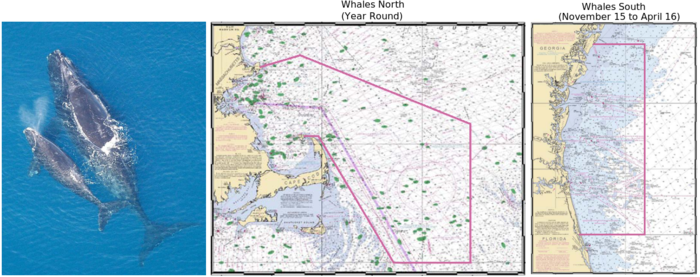PhOD hosts the Mandatory Ship Reporting System
The Mandatory Ship Reporting System aims to reduce the risk of ship strikes with northern right whales, and it requires all commercial vessels heavier than 300 gross tons to report to the Coast Guard upon entering two designated areas along the east coast of United States. Reporting ships receive an automated response containing instructions on how to reduce the risk of collisions. The new MSR v2.0, which is fully developed and maintained by PhOD personnel, started its operations on April 1, 2014.
The North Atlantic right whale has shown no significant signs of recovery over the past 60 years despite being a protected species. Ship strikes account for nearly one third of all known right whale mortality. In an effort to reduce the number of whales killed or injured by ship strikes, the United States proposed the creation of the Mandatory Ship Reporting System (MSR) to educate merchant mariners on the plight of the right whale, and to provide information about reducing the risk of ship strikes. The MSR was formally adopted in December, 1998, through the Resolution A.858(20), and commenced its operation on 1 July 1999. It requires all commercial vessels heavier than 300 gross tons to report to the Coast Guard upon entering two designated report areas: (1) the northeast area includes the waters off Cape Cod Bay, Massachusetts Bay, the Great South Channel, and the Stellwagen Bank National Marine Sanctuary; (2) the southeast area includes waters within 25 nautical miles of the coast along a 90 nautical mile stretch of the Atlantic seaboard in the vicinity of the Florida/Georgia border.

(left) North Atlantic right whale with calf, (center) Whales North area, and (right) Whales south area
AOML/PhOD houses the SEAS Program, which is used for oceanographic and meteorological observations transmissions. This program structure is now being used as the basis for the new MSR. AOML/PhOD has been awarded with the development, management and housing of the MSR, version 2.0. Reports sent by ships upon approaching the two designated areas are received through e-mail or Telex, processed and stored in the MSR database, and the system immediately returns a message providing the mariner with information on how to reduce the risk of collisions with whales. The outgoing message also provides latest right whale sighting information derived from NOAA-operated whale surveys.
The information collected by the MSR database yields data on ship traffic volume, routes, and ports of call and assists in tailoring any necessary future ship strike mitigation measures. It also enables the generation of reports about the ship compliance with the U.S. MSR.
Access to the MSR is available for registered users through the link: https://www.rightwhalesmsr.aoml.noaa.gov/